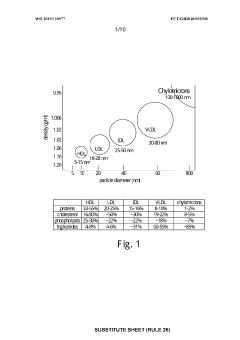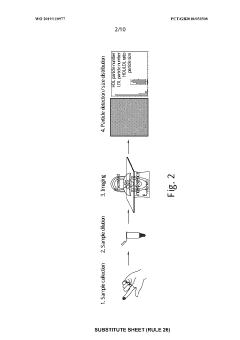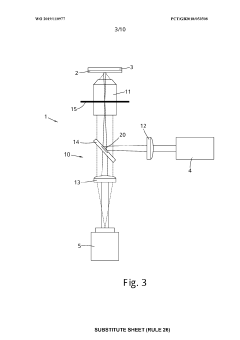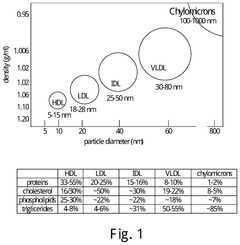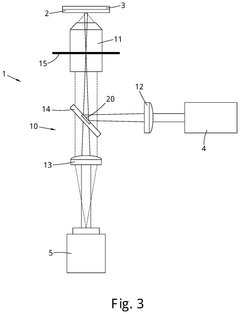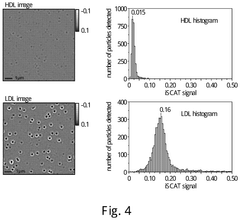Isotonic solutions and their role in light scattering for particle analysis
AUG 19, 20259 MIN READ
Generate Your Research Report Instantly with AI Agent
Patsnap Eureka helps you evaluate technical feasibility & market potential.
Isotonic Solutions Background and Objectives
Isotonic solutions have played a crucial role in particle analysis through light scattering techniques for several decades. These solutions, characterized by their osmotic pressure matching that of biological fluids, have become indispensable in various scientific and industrial applications. The development of isotonic solutions can be traced back to the early 20th century when researchers began to understand the importance of maintaining cellular integrity during experimental procedures.
The evolution of isotonic solutions has been closely tied to advancements in cell biology, biochemistry, and analytical techniques. Initially used primarily in medical and biological research, these solutions have found widespread application in particle analysis, particularly in the field of light scattering. The ability of isotonic solutions to preserve the size and shape of particles, especially biological samples, has made them invaluable in obtaining accurate and reproducible results.
Light scattering techniques, such as dynamic light scattering (DLS) and static light scattering (SLS), have emerged as powerful tools for particle characterization. These methods rely on the interaction between light and particles suspended in a medium, providing information about particle size, shape, and molecular weight. The use of isotonic solutions in these techniques has become increasingly important as researchers seek to analyze particles under conditions that closely mimic their natural environment.
The primary objective of utilizing isotonic solutions in light scattering for particle analysis is to maintain the structural integrity and native properties of the particles being studied. This is particularly crucial when dealing with biological samples, such as proteins, cells, or other biomolecules, which are highly sensitive to changes in their surrounding environment. By using isotonic solutions, researchers can minimize osmotic stress and prevent unwanted alterations in particle size or shape that could lead to inaccurate measurements.
Another key goal is to enhance the reliability and reproducibility of light scattering measurements. Isotonic solutions provide a stable and consistent medium for particle suspension, reducing the variability that can arise from changes in osmotic pressure or ionic strength. This consistency is essential for comparing results across different experiments and laboratories, contributing to the standardization of particle analysis protocols.
Furthermore, the use of isotonic solutions in light scattering techniques aims to bridge the gap between in vitro measurements and in vivo conditions. By closely mimicking physiological environments, these solutions enable researchers to obtain data that is more relevant to real-world applications, particularly in fields such as drug delivery, biomedical research, and diagnostics.
As technology continues to advance, the development of new and improved isotonic solutions remains an active area of research. Scientists are exploring novel formulations that not only maintain osmotic balance but also provide additional benefits such as enhanced particle stability, reduced aggregation, or improved compatibility with specific types of particles or analytical instruments.
The evolution of isotonic solutions has been closely tied to advancements in cell biology, biochemistry, and analytical techniques. Initially used primarily in medical and biological research, these solutions have found widespread application in particle analysis, particularly in the field of light scattering. The ability of isotonic solutions to preserve the size and shape of particles, especially biological samples, has made them invaluable in obtaining accurate and reproducible results.
Light scattering techniques, such as dynamic light scattering (DLS) and static light scattering (SLS), have emerged as powerful tools for particle characterization. These methods rely on the interaction between light and particles suspended in a medium, providing information about particle size, shape, and molecular weight. The use of isotonic solutions in these techniques has become increasingly important as researchers seek to analyze particles under conditions that closely mimic their natural environment.
The primary objective of utilizing isotonic solutions in light scattering for particle analysis is to maintain the structural integrity and native properties of the particles being studied. This is particularly crucial when dealing with biological samples, such as proteins, cells, or other biomolecules, which are highly sensitive to changes in their surrounding environment. By using isotonic solutions, researchers can minimize osmotic stress and prevent unwanted alterations in particle size or shape that could lead to inaccurate measurements.
Another key goal is to enhance the reliability and reproducibility of light scattering measurements. Isotonic solutions provide a stable and consistent medium for particle suspension, reducing the variability that can arise from changes in osmotic pressure or ionic strength. This consistency is essential for comparing results across different experiments and laboratories, contributing to the standardization of particle analysis protocols.
Furthermore, the use of isotonic solutions in light scattering techniques aims to bridge the gap between in vitro measurements and in vivo conditions. By closely mimicking physiological environments, these solutions enable researchers to obtain data that is more relevant to real-world applications, particularly in fields such as drug delivery, biomedical research, and diagnostics.
As technology continues to advance, the development of new and improved isotonic solutions remains an active area of research. Scientists are exploring novel formulations that not only maintain osmotic balance but also provide additional benefits such as enhanced particle stability, reduced aggregation, or improved compatibility with specific types of particles or analytical instruments.
Market Analysis for Particle Analysis Technologies
The particle analysis technology market has experienced significant growth in recent years, driven by increasing demand across various industries such as pharmaceuticals, biotechnology, environmental monitoring, and materials science. This market segment is characterized by a diverse range of applications, including particle size analysis, shape analysis, and concentration measurements, all of which rely heavily on light scattering techniques.
The global particle analysis market was valued at approximately $300 million in 2020 and is projected to reach $400 million by 2025, growing at a CAGR of around 5-6%. This growth is primarily attributed to the rising adoption of particle analysis technologies in quality control processes, research and development activities, and regulatory compliance across industries.
Within the particle analysis market, light scattering-based technologies hold a substantial share, accounting for nearly 40% of the total market revenue. This dominance is due to the versatility, accuracy, and non-destructive nature of light scattering techniques in particle characterization.
The pharmaceutical and biotechnology sectors are the largest end-users of particle analysis technologies, contributing to about 35% of the market revenue. These industries rely heavily on particle analysis for drug formulation, quality control, and ensuring the safety and efficacy of their products.
Geographically, North America leads the particle analysis market, followed by Europe and Asia-Pacific. The United States, in particular, holds the largest market share due to its strong presence in pharmaceutical and biotechnology research and development activities.
The market for isotonic solutions used in light scattering for particle analysis is closely tied to the overall particle analysis market trends. Isotonic solutions play a crucial role in maintaining the stability and integrity of particles during analysis, especially for biological samples. The demand for specialized isotonic solutions is expected to grow in parallel with the increasing adoption of light scattering techniques in life sciences and medical research.
Key market drivers include the growing emphasis on nanotechnology research, increasing investments in pharmaceutical R&D, and stringent regulatory requirements for product quality and safety. Additionally, the rising focus on personalized medicine and the development of novel drug delivery systems are creating new opportunities for particle analysis technologies, further boosting the demand for advanced light scattering solutions and associated isotonic media.
The global particle analysis market was valued at approximately $300 million in 2020 and is projected to reach $400 million by 2025, growing at a CAGR of around 5-6%. This growth is primarily attributed to the rising adoption of particle analysis technologies in quality control processes, research and development activities, and regulatory compliance across industries.
Within the particle analysis market, light scattering-based technologies hold a substantial share, accounting for nearly 40% of the total market revenue. This dominance is due to the versatility, accuracy, and non-destructive nature of light scattering techniques in particle characterization.
The pharmaceutical and biotechnology sectors are the largest end-users of particle analysis technologies, contributing to about 35% of the market revenue. These industries rely heavily on particle analysis for drug formulation, quality control, and ensuring the safety and efficacy of their products.
Geographically, North America leads the particle analysis market, followed by Europe and Asia-Pacific. The United States, in particular, holds the largest market share due to its strong presence in pharmaceutical and biotechnology research and development activities.
The market for isotonic solutions used in light scattering for particle analysis is closely tied to the overall particle analysis market trends. Isotonic solutions play a crucial role in maintaining the stability and integrity of particles during analysis, especially for biological samples. The demand for specialized isotonic solutions is expected to grow in parallel with the increasing adoption of light scattering techniques in life sciences and medical research.
Key market drivers include the growing emphasis on nanotechnology research, increasing investments in pharmaceutical R&D, and stringent regulatory requirements for product quality and safety. Additionally, the rising focus on personalized medicine and the development of novel drug delivery systems are creating new opportunities for particle analysis technologies, further boosting the demand for advanced light scattering solutions and associated isotonic media.
Current Challenges in Light Scattering Techniques
Light scattering techniques have become indispensable tools for particle analysis across various scientific and industrial applications. However, several challenges persist in this field, particularly concerning the use of isotonic solutions and their impact on measurement accuracy and reliability.
One of the primary challenges is the maintenance of particle stability in isotonic solutions during light scattering measurements. Isotonic solutions are designed to match the osmotic pressure of particles, preventing swelling or shrinkage. However, achieving and maintaining perfect isotonicity throughout the measurement process can be difficult, especially for complex biological samples or polydisperse particle systems.
The refractive index matching between particles and the surrounding medium poses another significant challenge. Isotonic solutions may alter the refractive index of the medium, affecting the scattering intensity and angular distribution of scattered light. This can lead to misinterpretation of particle size and shape, particularly for particles with refractive indices close to that of the solution.
Multiple scattering effects present a persistent issue in concentrated particle suspensions. While isotonic solutions help maintain particle integrity, they do not mitigate multiple scattering events. This phenomenon can lead to underestimation of particle size and distortion of size distribution profiles, especially in dynamic light scattering (DLS) measurements.
The presence of contaminants or impurities in isotonic solutions can significantly impact light scattering results. Even trace amounts of dust, bubbles, or aggregates can introduce artifacts in the scattering signal, leading to erroneous particle size determinations. Ensuring the purity and cleanliness of isotonic solutions remains a constant challenge in light scattering experiments.
Temperature control and stability during measurements present another hurdle. Isotonic solutions may exhibit temperature-dependent properties, affecting their refractive index and viscosity. These changes can influence the Brownian motion of particles and, consequently, the interpretation of light scattering data, particularly in DLS experiments.
The characterization of non-spherical or irregularly shaped particles in isotonic solutions remains challenging. Most light scattering theories and data analysis algorithms assume spherical particle geometry. Deviations from this assumption can lead to inaccuracies in size and shape determinations, especially for biological samples or complex nanostructures.
Lastly, the development of robust data analysis algorithms capable of accounting for the complex interplay between isotonic solutions and light scattering phenomena continues to be a significant challenge. Current models often struggle to accurately interpret scattering data from heterogeneous samples or systems with multiple particle populations in isotonic environments.
One of the primary challenges is the maintenance of particle stability in isotonic solutions during light scattering measurements. Isotonic solutions are designed to match the osmotic pressure of particles, preventing swelling or shrinkage. However, achieving and maintaining perfect isotonicity throughout the measurement process can be difficult, especially for complex biological samples or polydisperse particle systems.
The refractive index matching between particles and the surrounding medium poses another significant challenge. Isotonic solutions may alter the refractive index of the medium, affecting the scattering intensity and angular distribution of scattered light. This can lead to misinterpretation of particle size and shape, particularly for particles with refractive indices close to that of the solution.
Multiple scattering effects present a persistent issue in concentrated particle suspensions. While isotonic solutions help maintain particle integrity, they do not mitigate multiple scattering events. This phenomenon can lead to underestimation of particle size and distortion of size distribution profiles, especially in dynamic light scattering (DLS) measurements.
The presence of contaminants or impurities in isotonic solutions can significantly impact light scattering results. Even trace amounts of dust, bubbles, or aggregates can introduce artifacts in the scattering signal, leading to erroneous particle size determinations. Ensuring the purity and cleanliness of isotonic solutions remains a constant challenge in light scattering experiments.
Temperature control and stability during measurements present another hurdle. Isotonic solutions may exhibit temperature-dependent properties, affecting their refractive index and viscosity. These changes can influence the Brownian motion of particles and, consequently, the interpretation of light scattering data, particularly in DLS experiments.
The characterization of non-spherical or irregularly shaped particles in isotonic solutions remains challenging. Most light scattering theories and data analysis algorithms assume spherical particle geometry. Deviations from this assumption can lead to inaccuracies in size and shape determinations, especially for biological samples or complex nanostructures.
Lastly, the development of robust data analysis algorithms capable of accounting for the complex interplay between isotonic solutions and light scattering phenomena continues to be a significant challenge. Current models often struggle to accurately interpret scattering data from heterogeneous samples or systems with multiple particle populations in isotonic environments.
Existing Isotonic Solution Formulations
01 Light scattering measurement in isotonic solutions
Light scattering techniques are used to analyze particles in isotonic solutions. These methods can provide information about particle size, distribution, and concentration in biological or pharmaceutical formulations. The scattering of light by particles in isotonic solutions can be measured using various instruments and techniques to characterize the solution properties.- Light scattering measurement in isotonic solutions: Light scattering techniques are used to analyze particles in isotonic solutions. This method helps in characterizing the size, distribution, and behavior of particles or molecules in physiologically relevant conditions. The technique is particularly useful in pharmaceutical and biomedical applications for studying drug formulations and biological samples.
- Optical systems for analyzing isotonic solutions: Specialized optical systems are developed for analyzing isotonic solutions. These systems often incorporate advanced light sources, detectors, and signal processing algorithms to enhance the sensitivity and accuracy of measurements. They can be used for various applications, including particle size analysis, concentration determination, and quality control in pharmaceutical production.
- Isotonic solution formulations for reduced light scattering: Formulations of isotonic solutions are designed to minimize light scattering effects. This is crucial in applications where optical clarity is important, such as in ophthalmic solutions or in certain diagnostic tests. The formulations may include specific additives or processing techniques to reduce particle size or modify solution properties to minimize light scattering.
- Applications of light scattering in isotonic solutions: Light scattering in isotonic solutions finds applications in various fields. It is used in biomedical research for studying protein aggregation, in pharmaceutical quality control for detecting contaminants, and in clinical diagnostics for analyzing biological fluids. The technique provides valuable information about solution composition and particle characteristics in physiologically relevant conditions.
- Innovations in light scattering detection for isotonic solutions: Novel approaches are developed to enhance light scattering detection in isotonic solutions. These innovations may include new detection geometries, multi-angle light scattering techniques, or integration with other analytical methods. Such advancements aim to improve sensitivity, reduce interference, and provide more comprehensive characterization of particles in isotonic environments.
02 Optical systems for analyzing isotonic solutions
Specialized optical systems are developed for analyzing isotonic solutions. These systems may include light sources, detectors, and optical components designed to measure light scattering in isotonic environments. Such systems can be used for quality control in pharmaceutical production or research applications involving isotonic formulations.Expand Specific Solutions03 Isotonic solution formulation and light scattering properties
The formulation of isotonic solutions can affect their light scattering properties. Researchers investigate how different components and concentrations in isotonic solutions influence light scattering behavior. This knowledge is crucial for developing stable formulations with desired optical characteristics for various applications in medicine and biotechnology.Expand Specific Solutions04 Applications of light scattering in isotonic solutions
Light scattering techniques in isotonic solutions have various applications, including particle size analysis, protein aggregation studies, and quality control in pharmaceutical production. These methods can be used to monitor the stability of drug formulations, detect impurities, and characterize biomolecules in physiological conditions.Expand Specific Solutions05 Data analysis and interpretation of light scattering in isotonic solutions
Advanced data analysis techniques are employed to interpret light scattering measurements in isotonic solutions. These may include algorithms for particle size distribution calculations, correlation analysis, and modeling of scattering behavior. Accurate interpretation of light scattering data is essential for understanding the properties of isotonic solutions and their components.Expand Specific Solutions
Key Players in Particle Analysis Industry
The field of isotonic solutions and light scattering for particle analysis is in a mature stage of development, with a well-established market and proven technologies. The global market size for particle analysis is estimated to be in the billions of dollars, driven by applications in pharmaceuticals, materials science, and environmental monitoring. Technologically, the field has reached a high level of sophistication, with companies like Wyatt Technology, Malvern Panalytical, and Shimadzu offering advanced light scattering instruments. Major players such as DuPont and Olympus contribute to the ecosystem with complementary technologies and materials. Academic institutions like Texas A&M University and EPFL continue to push the boundaries of research, while specialized firms like Hamamatsu Photonics provide critical components for these systems.
Wyatt Technology LLC
Technical Solution: Wyatt Technology specializes in light scattering instruments for particle analysis. Their DAWN and miniDAWN multi-angle light scattering (MALS) detectors utilize isotonic solutions to maintain sample integrity during measurements[1]. These instruments employ a flow cell design that minimizes sample perturbation, allowing for accurate size and molecular weight determination of particles and macromolecules in solution[2]. Wyatt's technology incorporates advanced algorithms to analyze scattered light intensity at multiple angles, providing detailed information on particle size distribution, shape, and interactions in isotonic environments[3].
Strengths: High precision in particle characterization, versatility across various sample types, and minimal sample disruption. Weaknesses: Complexity in data interpretation and relatively high instrument cost.
Hamamatsu Photonics KK
Technical Solution: Hamamatsu Photonics specializes in photonics technology, including light sources and detectors used in particle analysis systems. For isotonic solution applications, they provide high-sensitivity photomultiplier tubes (PMTs) and photodiodes optimized for light scattering detection[13]. Their avalanche photodiodes (APDs) offer enhanced sensitivity for low-light applications, crucial for detecting scattered light from small particles in solution[14]. Hamamatsu's multi-pixel photon counters (MPPCs) provide single-photon detection capability, enabling highly sensitive measurements in dilute isotonic samples[15].
Strengths: Cutting-edge detector technology, high sensitivity for low-light applications, and versatility in integration with various light scattering instruments. Weaknesses: Focused on component supply rather than complete particle analysis systems.
Innovations in Light Scattering for Particle Analysis
Method of determining lipoprotein concentration in solution using light scattering
PatentWO2019110977A1
Innovation
- The use of single particle interferometric scattering microscopy (iSCAT) allows for the direct measurement of lipoprotein concentration in biological samples without purification, enabling the detection and quantification of lipoproteins in complex solutions by analyzing the binding of particles to a surface using light scattering.
Method of determining lipoprotein concentration in solution using light scattering
PatentPendingUS20250237603A1
Innovation
- The use of single particle light scattering, specifically interferometric scattering microscopy (iSCAT), allows direct detection and quantification of lipoprotein particles in complex biological samples without purification, by measuring the binding of particles to a surface using light scattering and calibrating the concentration based on binding rates.
Environmental Impact of Isotonic Solutions
The environmental impact of isotonic solutions used in light scattering for particle analysis is an important consideration in the broader context of sustainable scientific practices. These solutions, while essential for accurate measurements, can have various effects on the environment throughout their lifecycle.
The production of isotonic solutions often involves the use of chemicals and water resources. The manufacturing process may contribute to energy consumption and greenhouse gas emissions, particularly if large-scale production is required. Additionally, the packaging and transportation of these solutions can further increase their carbon footprint.
During the use phase, isotonic solutions generally have minimal direct environmental impact when handled properly in laboratory settings. However, improper disposal of these solutions can lead to environmental contamination. Many isotonic solutions contain salts and other compounds that, if released into water systems, could potentially alter local ecosystems and affect aquatic life.
The disposal of isotonic solutions presents a significant environmental challenge. While some solutions may be safely diluted and disposed of through standard wastewater systems, others may require specialized treatment or disposal methods to prevent environmental harm. Improper disposal can lead to soil and water pollution, potentially affecting both terrestrial and aquatic ecosystems.
Efforts to mitigate the environmental impact of isotonic solutions in particle analysis are ongoing. These include the development of more environmentally friendly formulations, such as using biodegradable components or reducing the concentration of potentially harmful substances. Some research is focused on creating reusable or recyclable isotonic solutions, which could significantly reduce waste and resource consumption.
Another approach to reducing environmental impact is the optimization of experimental procedures to minimize the volume of isotonic solutions required. This not only reduces waste but also decreases the overall resource consumption associated with production and transportation.
In the context of light scattering for particle analysis, there is growing interest in developing alternative techniques that reduce or eliminate the need for isotonic solutions. These may include dry particle analysis methods or the use of non-toxic, biodegradable suspending media.
As environmental concerns continue to gain prominence in scientific research, it is likely that future developments in particle analysis will increasingly focus on minimizing the ecological footprint of isotonic solutions. This may involve interdisciplinary collaborations between chemists, environmental scientists, and engineers to create more sustainable practices in this field.
The production of isotonic solutions often involves the use of chemicals and water resources. The manufacturing process may contribute to energy consumption and greenhouse gas emissions, particularly if large-scale production is required. Additionally, the packaging and transportation of these solutions can further increase their carbon footprint.
During the use phase, isotonic solutions generally have minimal direct environmental impact when handled properly in laboratory settings. However, improper disposal of these solutions can lead to environmental contamination. Many isotonic solutions contain salts and other compounds that, if released into water systems, could potentially alter local ecosystems and affect aquatic life.
The disposal of isotonic solutions presents a significant environmental challenge. While some solutions may be safely diluted and disposed of through standard wastewater systems, others may require specialized treatment or disposal methods to prevent environmental harm. Improper disposal can lead to soil and water pollution, potentially affecting both terrestrial and aquatic ecosystems.
Efforts to mitigate the environmental impact of isotonic solutions in particle analysis are ongoing. These include the development of more environmentally friendly formulations, such as using biodegradable components or reducing the concentration of potentially harmful substances. Some research is focused on creating reusable or recyclable isotonic solutions, which could significantly reduce waste and resource consumption.
Another approach to reducing environmental impact is the optimization of experimental procedures to minimize the volume of isotonic solutions required. This not only reduces waste but also decreases the overall resource consumption associated with production and transportation.
In the context of light scattering for particle analysis, there is growing interest in developing alternative techniques that reduce or eliminate the need for isotonic solutions. These may include dry particle analysis methods or the use of non-toxic, biodegradable suspending media.
As environmental concerns continue to gain prominence in scientific research, it is likely that future developments in particle analysis will increasingly focus on minimizing the ecological footprint of isotonic solutions. This may involve interdisciplinary collaborations between chemists, environmental scientists, and engineers to create more sustainable practices in this field.
Quality Control in Isotonic Solution Production
Quality control in isotonic solution production is a critical aspect of ensuring the reliability and effectiveness of particle analysis using light scattering techniques. The production of isotonic solutions requires stringent quality control measures to maintain consistency and accuracy in particle size measurements.
One of the primary quality control steps involves the precise measurement and adjustment of osmolality. Isotonic solutions must have an osmolality similar to that of human blood serum, typically around 290 mOsm/kg. Regular testing using osmometers is essential to verify and maintain this osmotic balance throughout the production process.
The purity of water used in isotonic solution preparation is another crucial factor. Ultrapure water, often produced through reverse osmosis and deionization processes, is necessary to prevent contamination that could interfere with light scattering measurements. Routine monitoring of water quality parameters, such as resistivity and total organic carbon content, helps ensure consistent solution quality.
pH control is also vital in isotonic solution production. The pH of the solution can significantly impact particle stability and light scattering properties. Regular pH measurements and adjustments using calibrated pH meters are necessary to maintain the desired pH range, typically between 7.2 and 7.4 for most biological applications.
Sterility is another critical aspect of quality control in isotonic solution production. Contamination by microorganisms can alter light scattering properties and compromise particle analysis results. Aseptic techniques, sterile filtration, and regular microbial testing are employed to ensure the sterility of the final product.
Particle size and distribution analysis of the isotonic solution itself is an important quality control measure. Techniques such as dynamic light scattering (DLS) can be used to verify the absence of unwanted particles or aggregates that could interfere with subsequent particle analysis experiments.
Stability testing is conducted to ensure that the isotonic solutions maintain their properties over time. This involves storing samples under various conditions and periodically testing their osmolality, pH, and particle size distribution to determine shelf life and optimal storage conditions.
Batch-to-batch consistency is crucial for reliable particle analysis. Implementing robust standard operating procedures (SOPs) and maintaining detailed production records helps ensure reproducibility across different production batches. Regular calibration and maintenance of all equipment used in the production and testing processes are also essential components of a comprehensive quality control program.
One of the primary quality control steps involves the precise measurement and adjustment of osmolality. Isotonic solutions must have an osmolality similar to that of human blood serum, typically around 290 mOsm/kg. Regular testing using osmometers is essential to verify and maintain this osmotic balance throughout the production process.
The purity of water used in isotonic solution preparation is another crucial factor. Ultrapure water, often produced through reverse osmosis and deionization processes, is necessary to prevent contamination that could interfere with light scattering measurements. Routine monitoring of water quality parameters, such as resistivity and total organic carbon content, helps ensure consistent solution quality.
pH control is also vital in isotonic solution production. The pH of the solution can significantly impact particle stability and light scattering properties. Regular pH measurements and adjustments using calibrated pH meters are necessary to maintain the desired pH range, typically between 7.2 and 7.4 for most biological applications.
Sterility is another critical aspect of quality control in isotonic solution production. Contamination by microorganisms can alter light scattering properties and compromise particle analysis results. Aseptic techniques, sterile filtration, and regular microbial testing are employed to ensure the sterility of the final product.
Particle size and distribution analysis of the isotonic solution itself is an important quality control measure. Techniques such as dynamic light scattering (DLS) can be used to verify the absence of unwanted particles or aggregates that could interfere with subsequent particle analysis experiments.
Stability testing is conducted to ensure that the isotonic solutions maintain their properties over time. This involves storing samples under various conditions and periodically testing their osmolality, pH, and particle size distribution to determine shelf life and optimal storage conditions.
Batch-to-batch consistency is crucial for reliable particle analysis. Implementing robust standard operating procedures (SOPs) and maintaining detailed production records helps ensure reproducibility across different production batches. Regular calibration and maintenance of all equipment used in the production and testing processes are also essential components of a comprehensive quality control program.
Unlock deeper insights with Patsnap Eureka Quick Research — get a full tech report to explore trends and direct your research. Try now!
Generate Your Research Report Instantly with AI Agent
Supercharge your innovation with Patsnap Eureka AI Agent Platform!
